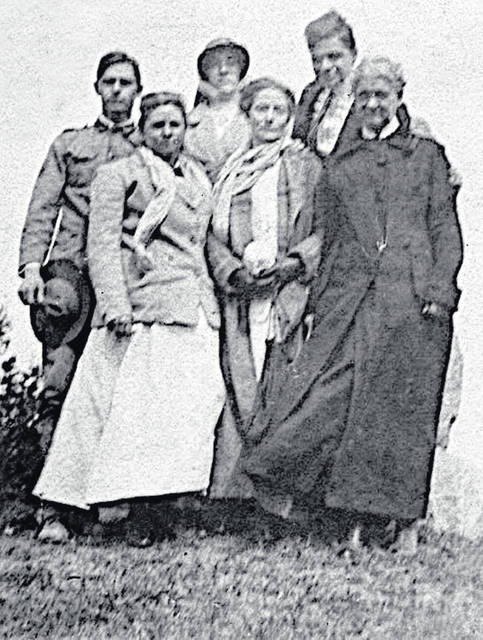
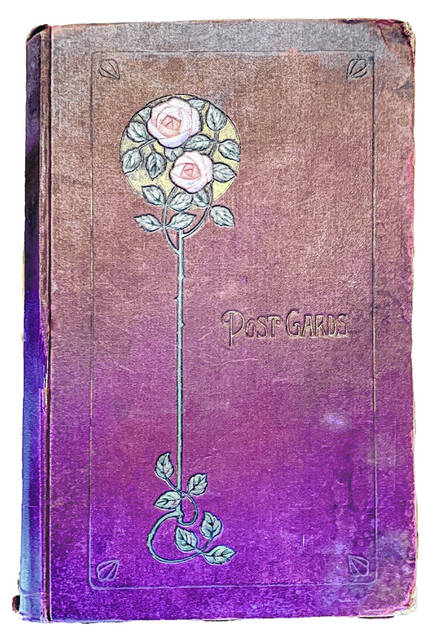
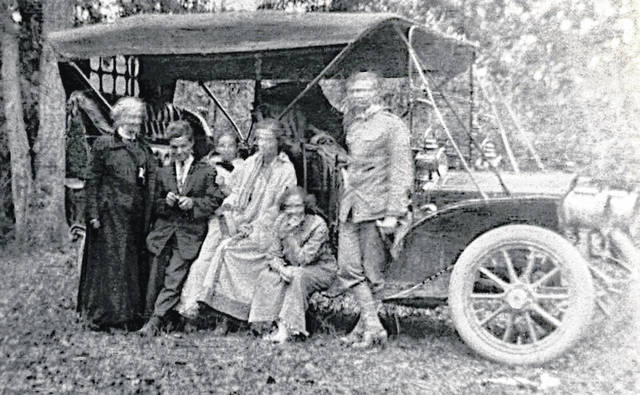
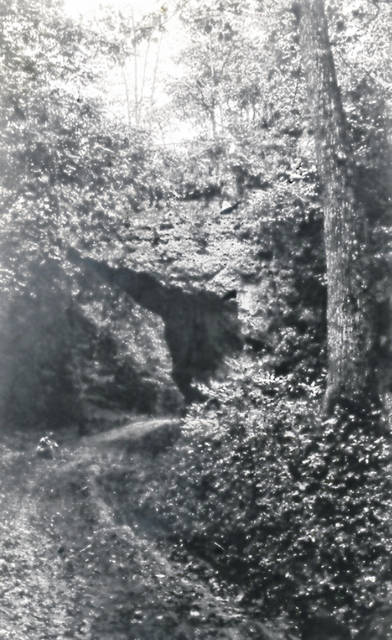
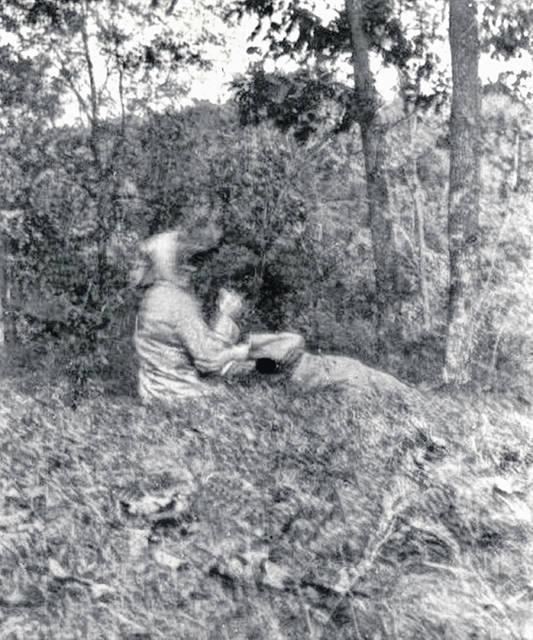
Editor’s note — Following are the recollections of Christopher S. Duckworth, a longtime Ohio Historical Society employee with family ties to Hillsboro and Greenfield, after he found a 108-year-old photo album belonging to his grandfather.
Sometime in 1913, 35-year-old Sarah Ella “Byrde” Ayres gave her 22-year-old brother, Edwin Billingham Ayres, an album containing an assortment of photographs, primarily of their family and which Byrde had taken and printed as photographic postcards. Both siblings were avid amateur photographers. At the time, Byrde worked as a bookkeeper for a Hillsboro grocery store. Edwin was a clerk at the W.R. Smith Drug Company in Hillsboro where he also was “reading” pharmacy in anticipation of becoming a registered pharmacist and hopefully owning the store eventually.
In addition to her real photo postcards, the album also contains other photographs of various sizes, dates and subjects. Most surely were not taken by Byrde. Some may have been taken by other family members, including Edwin and friends. The album appears to been abandoned as an active, or ongoing, project by the time that Edwin married in 1914.
On Sept. 14, 1913, Edwin, my grandfather, together with a group of relatives and friends, took an automobile excursion from their Hillsboro hometown to Serpent Mound State Memorial, a distance of only 20-some miles, but an arduous journey in those days of rutted dirt roads, few maps, and no service stations. But the group enjoyed being with one another, had traveled previously, and were ready for a new adventure.
Along with my grandfather was his soon-to-be fiance, Edith Pearl Laymon; his older sister Byrde; their aunt, Harriet Lavina Ayres; their cousin, Charles E. Ayres; and an unidentified woman.
The photographic prints in a section of the album are of poor quality, are contact prints, and are approximately 2 ½ by 1 7/8 inches. The camera used likely was a Kodak Vest Pocket Camera, which had been introduced the previous year and had become a very popular camera. Adjustments were few, however, and both negatives and subsequently prints often were poor, especially by today’s standards. Such certainly is the case in hand.
This strikes me as very odd, however. Both my grandfather and Byrde were avid photographers who had been taking images for years and their cameras were far superior to the Vest Pocket Kodak. Both photographers had exhibited considerable skill, certainly far superior to the album’s images. Byrde went on to become a professional photographer and owner of Ayres Art Studio and my grandfather continued to hone his photographic skills as a much-recognized amateur. So, perhaps Cousin Charles was the camera’s owner and photographer.
To return to September 1913, the first image of the expedition shows the group, sans Byrde, gathered around their automobile. My grandfather is dressed in his Boy Scout uniform. He was an early scout leader in Hillsboro.
Byrde no doubt pressed the shutter, and she also wrote brief captions for most of the Serpent Mound prints.
I believe that the automobile is my grandfather’s E-M-F touring car. The E-M-F company, founded by Barney Everitt, William Metzger and Walter Flanders, was first produced in 1909 and for a period was very successful — only Ford outsold it. The company, however, had both quality control and management issues, and in 1910 Studebaker purchased it. The E-M-F name continued to be used through 1912 when they became Studebakers. My grandfather very much liked his E-M-F.
Another image shows Sarah Ella “Byrde” Ayres, Aunt Harriet Lavinia Ayres, who was a Methodist missionary recently returned from Mexico, an unknown woman, my grandfather Edwin Ayres, his soon-to-be fiance Edith Pearl Laymon and the sibling’s cousin Charles E. Ayres.
A third photograph is of an unnamed area somewhere in the vicinity of Serpent Mound. Byrde titled it: “Notice the People in the Distance Under the Rock.” This leads me to believe that they were not members of their party, but a pair who the group encountered as they explored the area.
Edwin and Edith had just begun to date at about the time of this excursion. He was from Hillsboro while she was from the Lynchburg-Dodsonville area. Soon to become a registered pharmacist and with assured employment at the W. R. Smith Drug Company, the couple’s future looked bright. On Dec. 22, 1914, the pair married. Six years later, their only child was born: my mother, Clara Elizabeth Ayres.
The final image of the excursion is one of the groomed Serpent Mound, taken from a slight ground-level rise, which is somewhat surprising. In July 1908, the Ohio General Assembly made a special appropriation of $500 to the Ohio State Archaeological and Historical Society to fund the construction of an observation tower at Serpent Mound State Park. The Columbus Wire & Iron Works was chosen to build it. When erected in August 1908, the iron tower, weighing three tons, was 25 feet high with an eight-foot-square viewing platform atop the structure. The tower was an immediate success and continues to overlook the earthwork today.
Surely the group, or at least some of them, ascended the stairs to enjoy the vantage point. Who could resist — I cannot.
Serpent Mound, the largest effigy mound in North America and one of only two effigy mounds in Ohio, long has been a site of speculation and wonder. The landmark was surveyed carefully and recorded by pioneer archaeologists Ephraim Squire and Edwin Davis in 1846 when it was tree-covered. Two years later, Squier and Davis’ illustrated report appeared in “Ancient Monuments of the Mississippi Valley,” which was published by the newly founded Smithsonian Institution.
Frederic Ward Putnam of the Peabody Museum of Archaeology and Ethnology at Harvard University studied, lectured and published on Ohio mounds, especially Serpent Mound. When he visited the Midwest in 1885, he was dismayed to discover that advancing development was destroying many Ohio earthworks. To prevent such a fate for Serpent Mound, in 1886 Putnam approached a group of wealthy Boston women seeking funding to purchase the site. He raised enough to buy 60 acres of the Lovett farm. The purchase also included three conical mounds, a village site and a burial place.) The trustees of the Peabody Museum in 1900 entered into an agreement with Ohio State Archaeological and Historical Society with several stipulations to ensure that the park “will be free to all.”
Putnam also chastised Ohioans for allowing the wholesale destruction of that state’s many earthworks and not taking steps to ensure the preservation of those that remained. He asked, “will not the people of Ohio be aroused to the importance of securing others from destruction?…I pray that it may be done.”
Without question Serpent Mound was the subject of much speculation and was recognized as an archaeological and natural history site of incredible importance. In addition both 19th and 20th century visitors found the bucolic venue ideal for picnics and other gatherings where they could combine fellowship with discovery and education. I have no doubt but that the Highland County group so found their 1913 outing, as do their progeny today.
Christopher S. Duckworth spent three decades at the Ohio Historical Society, where he was founding editor of Timeline magazine, followed by another 10 years at the Columbus Museum of Art. Today, he owns his own publishing company, Brevoort Press LLC.






